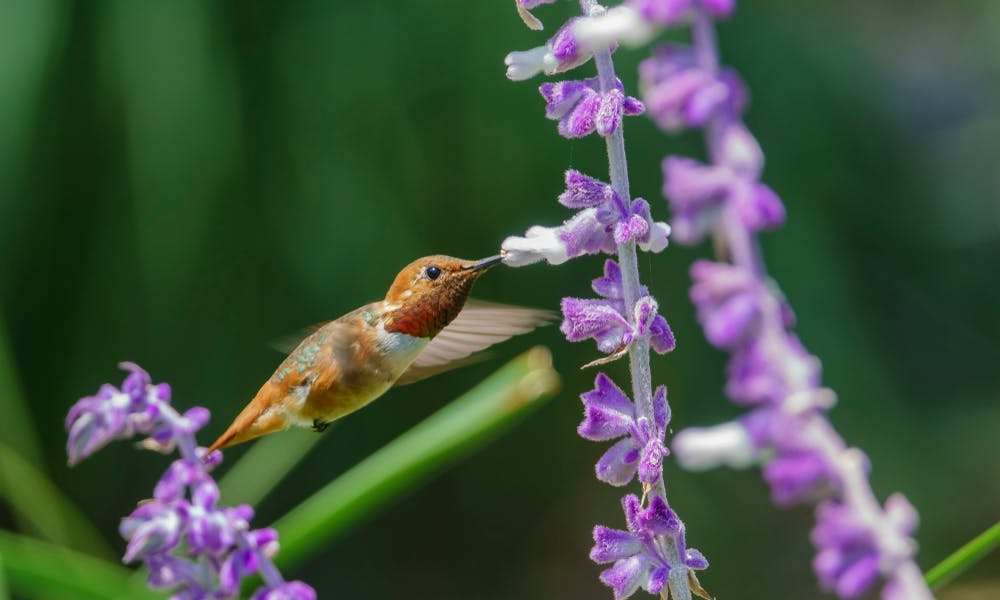MENU
Plants and Flowers to Attract Hummingbirds

The sight of a sweet hummingbird flitting around the garden is enough to put a smile on anyone’s face. For many, this is a chance sighting and only happens on those very lucky days. But did you know that there are many plants that hummingbirds find particularly irresistible?
Including sweet nectar plants in your garden is a sure-fire way to catch a glimpse of the tiny birds. To really create a proper hummingbird sanctuary, there are a few things to take into consideration. Let’s take a closer look at the bird itself. There is no better way to attract a hummingbird than first to understand the creature. Then, we look at things to take into consideration to create a hummingbird habitat. Finally, we list some plants that hummingbirds love to visit.
In this post, we are going to share:
- Types of hummingbirds
- Creating a hummingbird garden
- Plants for hummingbirds
A Closer Look at Hummingbirds
While we may only see a few types of these birds in each region, throughout the Americas, there are actually over 350 different species. The vast majority live in tropical areas, with only about eight breeds being seen regularly throughout Canada and the US.
Hummingbirds are quite tiny, especially in comparison to other birds. The average weighs in at only 4 grams! Of course, like most other animals, there are both miniature and ‘giant’ versions, too. The largest of the hummingbird species weighs close to 20 grams while the smallest weighs only 2 grams.
Hummingbirds live in a nest-like most other birds. Their nest is often tiny and tucked inside a bush or in the fork of a tree. The nests do not look like a typical bird’s nest. Instead of twigs, they are made up of moss, lichen, and spider silk.
One of the most interesting characteristics is the rate at which a hummingbird beats their wings. Most species have a flap rate of 50-80 flaps per second. Their wings move so fast it is hard for humans to see the movement. This is why it looks like the bird floats when visiting a flower.
Creating a Hummingbird Garden
Take a look at your yard and come up with a location for your new friends. Try and find a spot close to a window or patio door. That way, you can enjoy the birds from both inside and outside your home. Then take an inventory of your existing yard. You do not have to start over. Work with what you have to expand and enhance your space.
Don’t limit your space to only a garden. Hummingbirds fly so you can grow up instead of out. Trellis or the sides of buildings are excellent places to plant climbing flowers. If you don’t have the ability to grow on walls, try created a tiered flower pot structure. Balancing smaller pots on top of larger ones creates a more growing room without taking up space.
Interestingly, Red Flowers are the most attractive to a hummingbird while whites and yellows are least likely to attract them. Trumpet-shaped flowers are excellent nectar producers for the birds. Try to avoid open-faced flowers. While they may smell great, they provide little nectar, so the birds won’t stick around.
It is a good idea to plant several of the same plants. This gives hummingbirds the ability to flit from plant to plant to collect nectar. Also, think about using a variety of plants that flower at different times. This means that the little birds have a nectar source throughout the entire growing season.
Like most other birds, hummers require a water bath. These birds are tiny, so the basin should be quite shallow. Consider adding a small fountain or water feature to your yard. It not only adds visual appeal but can double as a birdbath. Hummingbirds also need a place to perch. Any woody plants that are existing in your yard should do just fine. If you don’t have anything like that, create a perch out of old wood.
Plants for Hummingbirds
While many plants may attract hummingbirds to your garden, not all of them can keep them there. The flowers’ ability to produce nectar makes the decision for a hummer to stick around. It is okay to use sweet-smelling, non-nectar producing plants to get the birds there. But make sure you have sufficient nectar plants to keep the birds coming back. Here are a few suggestions for nectar-producing flowers:
Bee Balm – This plant, also known as monarda or bergamot, has red to purple flowers. They grow up to 4′ tall and 3′ wide. For best results, plant in full sun, though it can tolerate a little bit of shade.
Lupine – On average, Lupins grow 3′ tall and 3′ wide. They are available in many colors, so choose reds and oranges for Hummingbirds. These plants self-seed so can spread all over your garden. This is good for the birds but maybe not go good for overall visual appeal.
Lily – There are many varieties of lilies, but most can attract hummingbirds. Liies have the characteristic trumpet-shaped flowers, so make sure to choose ones with red or orange flowers. Depending on the variety you plant lilies can grow as tall as 8’, so make sure you know what you are purchasing.
Creating a yard to attract hummingbirds is not overly complicated. It makes time and careful planning but putting effort in at the beginning pays off in the end. With all gardening, remember to be patient. It may take time for the birds to find you, but once they do, the birds come back year after year.

